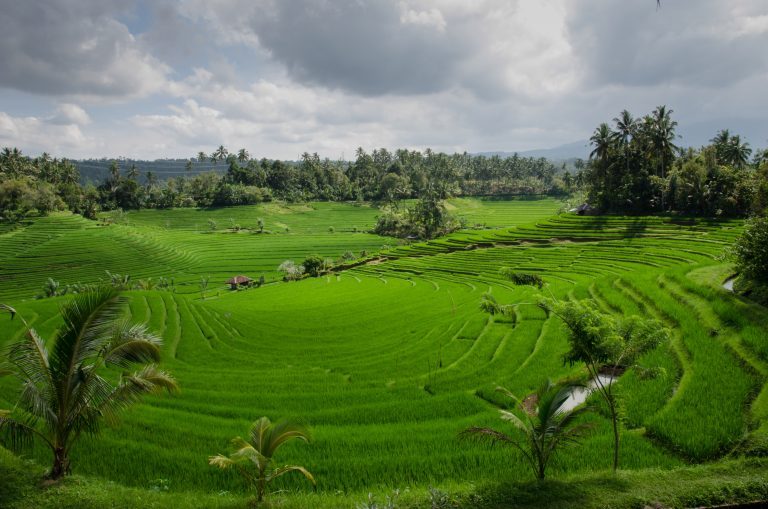Every day we consume products or services that are based on natural resources being extracted around the globe. In order to meet this consumption level, the worldwide extraction of biotic and abiotic natural resources increased by 73 billion tonnes since 1970 reaching a raw material extraction of more than 104 billion tonnes by 2024 (find more information on trends in the story Global trends of material use).
Extracted natural resources, either processed or unprocessed, as well as (intermediate) goods are intensively traded around the globe. Globalisation trends are leading to an ever-increasing interconnectedness and complexity of the global economic system, which results in a detachment of production and consumption in geographical terms. Thereby, the transfer of raw materials from resource-abundant to resource-scarce countries is a very frequent pattern. As a result, domestic final consumption has become the end-point of a large number of long, international and intricate supply chains.
Accounting for material consumption
To account a nation’s consumption, two different indicators can be used: Domestic Material Consumption (DMC) is currently the most widely used and accepted consumption indicator. It is calculated as domestic extraction plus the weight of all imports minus the weight of the exports and as such allows to answer policy questions such as “Which raw materials serve the consumption of a country?” However, it is important to notice that the DMC does not take into account the materials needed along the supply chains of traded goods, which represents its main restriction from an analytical point of view. Alternatively, the indicator Material Footprint (MF, also called RMC) accounts for the physical quantity of materials required along the supply chains of all goods and services finally consumed in a country – the so-called “raw material equivalents” (RME). The MF is calculated as the sum of domestic extraction and the imports measured in RME minus the exports in RME. Thus, it provides a more comprehensive picture of a nation’s material consumption and allows policy questions like “Which are the domestic and foreign hot spots for resource management measures related to the domestic final demand of materials?” Find out more about methodological details in the Methods section.
Hence, DMC and MF answer different types of policy questions. MF can be seen as complementary to DMC, as it allows considering the growing extent of international trade, its complexity and the dependence of countries with low material endowments but highly developed service sectors from countries rich in raw materials or cheap labour.
The big gap between DMC and MF
Because supply chains of goods and services are increasingly organized on the global level, it becomes ever more important to understand the impact of global value chains on a country’s economic performance. Comparing the two consumption indicators and monitoring the trends of DMC and MF, enables to picture nations’ interdependencies regarding global supply chains either due to missing endowments of particular material types or due to outsourcing activities of economic sectors.
A comparison of DMC and MF will usually show for countries with large material endowments and an economic focus on the raw material sector a higher per-capita DMC than MF. This is due to the fact that, in the case of DMC, the ore extraction needed to produce a specific metal for the export market is allocated to the exporting country, while the weight of the exported materials is allocated to the importing country. In contrast, the MF translates the exports to a country into their raw material equivalents (see above), which include the ore extraction. Hence, extraction quantities are allocated to the importing country, and the extracting country’s MF decreases.
Typical examples for these phenomena are Chile and Germany, with Chile building its economy on its metal (especially copper) production and exports, and Germany being a service-sector-based economy importing in its majority raw materials only indirectly via processed or finished goods. Countries like Australia with a diversified economy but still a strong mining sector show less difference but still a higher DMC.
The other important aspect of such a comparison is the difference in per-capita DMC or MF between countries, as they show explicitly how industrialised and wealthy countries show, in general, higher levels of per-capita DMC and considerably larger per-capita MF.
A regional perspective on material consumption
While differences in raw material consumption between industrialised, emerging and developing countries and regions are considerable, a look at the trends in the regions’ material footprints (MF, also called RMC) shows a shift from the industrialised “old world” to the emerging economies. This is for two reasons – demographic developments and, more importantly, the acceleration in economic and social development and, as a consequence, of consumption.
Since 1970, the share of global raw material consumption changed remarkably among world regions, showing an increasing role of Asia, from 25% in 1970 to 57% in 2024. The increasing relevance of Asia in terms of material consumption can be explained by the rapid industrialisation of countries such as China and India and the simultaneous increase of the countries’ middle class and consumption levels. China’s demand for raw materials, for instance, caused an increase of MF by more than a factor of 16 from 2.1 Bt in 1970 to 36.8 Bt in 2024. In India, MF almost quadrupled in the same period. In contrast, the role of Europe (from 25% to 12%) and North America (from 22% to 11%) became less important.
Note: Hover over the graph to view the respective values. To access and modify this visualisation open it via the visualisation tool.


